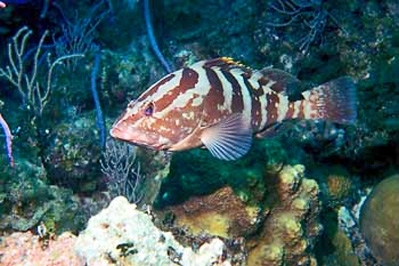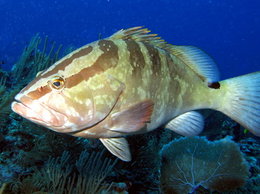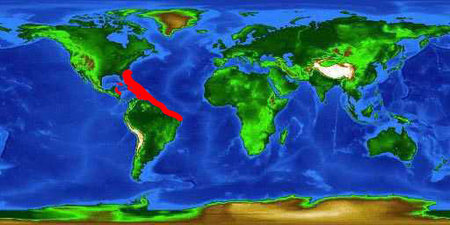Nassau grouper
Contents
Introduction
The Nassau grouper (scientific name: Epinephelus striatus) is a member of the grouper/seabass family (Family Serranidae) that lives on coral reefs in the Western Atlantic Ocean and Caribbean Sea. This species has been overfished, and the range has been correspondingly narrowed from its historic distribution.
|
Scientific Classification Kingdom: Animalia (Animals) |
Physical Description
Nassau groupers are large fishes that range in size from 0.25 to 1.22 meters in length and can reach a maximum weight of 25 kilograms. Their thick bodies are light with five dark bars on their backs. They have a diagonal bar from the snout, through they eye, to the dorsal fin and a dark blotch on the base of their tail. They can change colors in a few minutes
Distribution
The species is found in the Western Atlantic including Bermuda, Florida, Bahamas, Yucatan Peninsula and throughout the Caribbean to southern Brazil. They are not known from the Gulf of Mexico except at the Campeche Bank off the coast of Yucatan, Tortugas, and off Key West, Florida. Due to overfishing, the species is now found in a more limited range from its historic domain.
Habitat
Nassau groupers are found in shallow waters up to 90 meters deep associated with the reef or other rocky substrates. They are found from the shoreline to at least 90 meters in depth and they are usually close to caves. Juveniles are common in seagrass beds.
Feeding Behavior
Nassau groupers are generalist carnivores that feed on fishes (parrotfishes, wrasses, damselfishes, squirrelfishes, snappers, and grunts) crabs, lobsters, and octopuses. Fish make up about one half of the diet and crabs make up another quarter of the diet. They are ambush predators that sit and wait for their prey to pass by. They capture food by opening their massive mouths and spreading their gill covers to create suction that draws water, and prey, into their mouths. Prey are generally captured whole and they use a series of strong teeth to grasp the prey and keep them from escaping.
Behavior
They are generally solitary, moving slowly through large home ranges, although they may sometimes form schools. Spawning aggregations of Epinephelus striatus have been studied with some detail in locales throughout the tropical western Atlantic Ocean region; these aggregations have been found to be as sizable as 100,000 individuals.
Reproduction
Nassau grouper forms large spawning aggregations. In the winter on a full moon, individuals gather in large numbers, ranging from a couple dozen to over 100,000, at specific locations on the outer reef at depths from 20 to 40 meters. Males court females by swimming in vertical spirals and swimming horizontally across the bottom. Females release eggs in the water column where they are fertilized by males. After the eggs hatch, the larvae enter the pelagic stage where they remain for about a month. When the larvae reach about 32 millimeters in length they settle in vegetated areas near coral patches. Once they reach 120 to 150 millimeters in length, the juveniles move from the vegetation to the coral reef where they may live up to 16–32 years.
Nassau groupers are protogynous hermaphrodites, which means they change sex from female to male. Individuals may reproduce as females for several years before changing into males although some males never go through the female stage.
Associations
A variety of fishes feed on Nassau groupers including the great barracuda, moray eels, sandbar sharks, and the great hammerhead shark.
Nassau groupers are infected by a variety of parasites including, isopods that live in their nostrils, larval tapeworms, and nematodes that live in their ovaries. Thus, Nassau groupers are frequent visitors to cleaning stations where cleaner fishes and shrimps remove isopods from their bodies, mouths and gills.
Conservation Status
The Nassau grouper has been heavily fished and its populations are particularly susceptible because fishermen capture them in large numbersduring the breeding aggregations that occur predictably in the same locations at the same times each year.
The Nassau grouper is classified as Endangered by the World Conservation Union (IUCN) (World Conservation Union (IUCN)), a global union of states, governmental agencies, and non-governmental organizations that form a partnership to assess the conservation status of species.
References and Further Reading
- Encylopedia of Life. 2011. Epinephelus striatus (Bloch, 1792)
- Ichthyology. 2011. Nassau Grouper
- Smithsonian Marine Station at Fort Pierce. 2011. Epinephelus striatus
- Humann, P. and N. Deloach (Editor), 1994. Reef Fish Identification: Florida, Caribbean, Bahamas. New World Publications, Inc. Jacksonville, FL. ISBN: 1878348078
- Deloach, N. 1999. Reef Fish Behavior, Florida, Caribbean, Bahamas. New World Publications, Inc. Jacksonville, FL. ISBN: 1878348280


